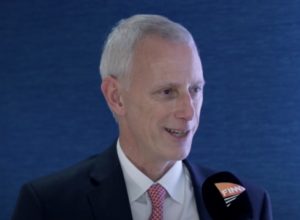FINN talks to Chris Cholerton, President – Civil Aviation at Rolls Royce about the dual challenges of post-Covid recovery and the company’s three pillar approach to reaching Net Zero
With aviation and aerospace setting a flight path to net zero, Rolls-Royce Civil Aviation has put sustainability at the heart of its business strategy.
Chris Cholerton, President – Civil Aviation at Rolls-Royce explained how the approach was being adopted across the manufacturer’s business units: “We’ve placed it very much at the heart of our strategy as a group, not just in the aerospace side but across our power systems business too. We see it an opportunity, we’re a technology company and the technology changes are going to be central to the drive to net zero, so we very much see ourselves as part of the solution.”
Three pillars to sustainability
Cholerton said the manufacturer took a three-pronged approach to sustainability, providing different solutions to suit the existing fleet and new transport types. “There are three main pillars to our strategy in the aviation sector. One is to drive ever more efficient gas turbines, because for any aircraft flying a long way with lots and passengers, we’re going to be powered by gas turbines for a long, long time.”
“To that end, next year we’ll run, for the first time, our next generation of aero engine called the Ultrafan which is an architectural change which will be the family of engines beyond our Trent engines with a 25 per cent improvement in fuel efficiency relative to the first generation of Trent.”
“Secondly, we’re promoting and testing and demonstrating sustainable aviation fuels (SAF) because those gas turbines in the future are going to need to run on sustainable aviation fuels and here we’re testing engines both on the ground and in the air to demonstrate compatibility of our engines with a 100 per cent sustainable aviation fuel.”
Cholerton said the Trent 1000, Trent XWB and business jet engines had already undergone testing with SAF. “By the time that the COP-28 is here in Dubai in 2023, we’ll have met our commitment to demonstrate compatibility with all our modern engines of 100 per cent and all our Trent engines of 100 per cent sustainable aviation fuel and then it’s very much about influencing policy, governments to ramp up production of that sustainable fuel, the third pillar of our strategy is more disruptive technologies such as electric power for aviation, hybrid electric power and indeed hydrogen.”
Cholerton cited Rolls-Royce’s world record setting electric flight by the ACCEL project’s Spirit of Innovation, which he said was more about demonstrating technological advances such as battery power, electronics and system integration which could then be applied to other markets such as the urban air mobility market.
Industry needs 400 times amount of SAF produced today to meet targets
Although the technology was advancing, Cholerton warned the move away from fossil fuels to reduce emissions would be complex. He said: “It is a challenge. It’s not going to be easy to decarbonise aviation, but then aviation’s got a very good record of tackling difficult challenges. As I said, we very much see ourselves as part of the solution, being a technology and engineering company.”
“On sustainable fuel, we’ll have demonstrated that our engines can be compatible with a 100 per cent fuel by 2023 so then it’s very much about how we, with the partners in the industry, influence policy so that we can ramp up the production. The industry needs 400 times the amount of SAF that’s produced today to meet a 10 per cent mandate by 2030 and then we’ve got to go beyond that.”
Commitments to sustainability “getting much more real”
With demand in freefall during the pandemic, survival has been the main agenda for Rolls-Royce along with other aviation sector companies. Cholerton said the company had been through a major restructuring process “to scale ourselves to the new lower demand.”
He added there had been a change in the “mindset about sustainability” during the pandemic. “It was always a conversation pre-Covid but it’s now very much more to the fore and the commitments are getting very much more real, ” he explained.
“I think the urgency and the need to deliver tangible results is pervading the industry and the IATA AGM recently in Boston confirm that with the resolution to commit to net zero by 2050. That conversation has certainly changed in tone and leads to all the opportunities I’ve just described.”

